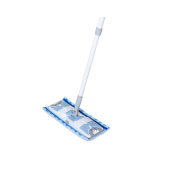Remember the days of paper-filled offices and confusing spreadsheets saved in different places on your computer? They start to feel quite outdated, don’t they?
Today, procurement professionals around the world are embracing newer, better ways of managing their supply chains with digital tools.
But what do we mean by ‘digital supply chain’?
Simply put, supply chain digitization means swapping out old manual systems for smarter, connected digital tools. Imagine going from jigsaw puzzle pieces everywhere to a clear, finished picture. These new tools help businesses like yours pull all their information into one easy-to-use place, making things run smoother and faster.
In this article, we will walk you through some best practices to successfully implement this digital shift into your workflow, highlighting the benefits, and offering insights on navigating the potential challenges.
Here are the topics we will cover:
- Difference Between Traditional And Digital Supply Chains
- What Are the Benefits of Supply Chain Digitization?
- How to Implement a Digitized Supply Chain Strategy
Difference Between Traditional And Digital Supply Chains
The landscape of supply chain management is changing, not with baby steps, but with digital leaps. And while both traditional and digital methods have their merits, there’s an undeniable tilt towards the latter, courtesy of its advanced capabilities.
For many decades, businesses have relied on traditional supply chains, which, despite leveraging technology to an extent, are distinctively different from today’s digital supply chain trends. A typical example? Traditional supply chains might employ a standalone inventory management system isolated from the company’s finance or order management systems. On the contrary, a digital supply chain offers integrated technology systems where everything from inventory to financials is connected and accessible in real-time, creating transparency and eliminating the walls between various supply chain segments.
Moreover, traditional supply chains operate based on historic patterns. Think of a procurement manager at a construction company purchasing more dust masks based on a previous project’s consumption. While this approach has its merits, it’s reactive. When shifting to digital practices, the same procurement manager will be able to rely on accurate data to gauge and respond to immediate market fluctuations, identify risks, and pivot strategies dynamically. For instance, the same procurement manager will be able to anticipate a sudden spike in demand for specialized safety equipment during a season with a higher forecast of airborne contaminants
On top of that, lead times in traditional supply chains tend to be more extended, largely because of manual processes that dominate various stages. Consider the time taken from receiving a purchase order, manually checking inventory, processing the order, and then shipping it. The digital supply chain, with its advanced supply chain tools, slashes these times considerably.
In sum, while traditional supply chains have paved the way, the digital supply chain, enriched with suppliers’ technology and revamped supply chain management processes, is steering businesses towards a future defined by efficiency, agility, and intelligence.
What Are the Benefits of Supply Chain Digitization?
Ever been faced with the daunting task of making procurement decisions on limited data? As the world of procurement evolves towards a virtual trajectory, tapping into the power of a digital supply chain might be your game-changer.
Here are 3 reasons why:
- Boost Financial Management: Imagine being a procurement manager for an automotive parts company. A digital supply chain can be your window into real-time inventory checks. Whether it’s brake pads or transmission systems, knowing stock levels instantly can be a lifesaver. You can then strategically allocate a budget for what’s needed, ensuring that funds aren’t wasted on overstocking, nor is production halted due to shortages.
- Minimize Lead Times & Leverage Automation: Have you ever struggled to ensure timely delivery of goods? Imagine a procurement manager responsible for personal protective equipment (PPE) in a large manufacturing facility. With a digitized system in place, the moment stock levels of safety goggles or gloves approach a minimum threshold, an automatic replenishment order can be placed with the vendor. This guarantees that workers are never left exposed due to PPE shortages.
- Enhance Decision-Making With Analytics: Knowledge, when timely, can tilt scales in procurement decisions. Picture a procurement manager responsible for sourcing PPE for a network of hospitals. With the power of a digital supply chain, they can monitor real-time usage rates of items like surgical masks or face shields across different facilities. If one hospital is going through N95 masks at a faster rate due to a sudden outbreak, the system can alert the manager, enabling them to redistribute supplies or adjust orders promptly. This ensures frontline workers always have the protection they need without unnecessary stockpiling or wastage.
How to Implement a Digitized Supply Chain Strategy
Ever felt the rush of excitement when you switched out an old mobile phone for the latest model? That transition from old to new, while thrilling, requires some getting used to.
On the same note, transitioning from a traditional supply chain to a digital one requires preparation and thoughtful execution.
Here, are 5 best practices we recommend you follow:
- Define Your Goals: Before any major shift, determine your specific objectives. This could involve achieving enhanced control over your PPE stock levels to address the fluctuating demands in safety regulations, to name one.
- Start Small and Scale: Implementing an advanced supply chain system all at once can be overwhelming. Instead, take a phased approach. Begin by digitizing a single process or department, and once you’ve established a smooth workflow, move on to the next.
- Ensure Interoperability: It’s no use having cutting-edge software if it can’t communicate with other systems in your organization. Ensure whatever digital tools you adopt are compatible with existing systems or consider upgrading systems that are too outdated.
- Train the Team: A digital tool is only as good as the person using it. Training sessions not only acquaint your team with new software but also instil confidence in them to use it to its fullest potential.
- Stay Updated: The realm of digital supply chains is ever-evolving. What’s considered best-in-class today might become outdated in just a few years. Regularly reviewing supply chain trends and undergoing periodic system upgrades will help you stay ahead of the curve.
In essence, transitioning to a digital supply chain is a holistic approach that requires goal-setting, iterative implementation, team training, and knowledge of the latest trends.

Conclusion
Recalling those days of cluttered offices and baffling spreadsheets saved in obscure folders, it’s evident how far we’ve travelled. Today, digital supply chains provide businesses with streamlined processes, bringing their efficiency to new heights.
While the traditional approaches have their merits, they often leave procurement professionals grappling with unpredictable stock levels. In contrast, today’s digitized systems allow for accurate demand forecasting, real-time inventory assessments, and strategic restocking.
Of course, implementing your own digital supply chain requires a holistic approach and a clear understanding of both your goals and the risks involved. However, when done right, the rewards will outweigh the efforts.

















